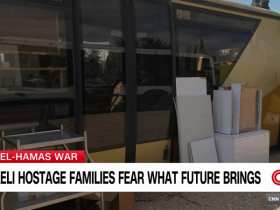A US navy ship intercepts missiles launched by Houthi rebels in Yemen. Two American bases in Syria come under fire. In Iraq, drones and rockets fired at US forces.
Gaza may be where the war is happening now, but across the Middle East the warning lights of more trouble to come are blinking red.
The US has deployed two carrier groups to the eastern Mediterranean to deter Iran and its allies Syria and Hezbollah from opening new fronts against Israel. Two thousand US Marines are on hard standby for deployment to the region.
US President Joe Biden spent seven hours in Israel Wednesday, voicing full support for Israel’s campaign against Gaza, albeit urging Israeli leaders, and repeating it in his Thursday evening speech from the White House, not to be blinded by rage. Biden is pledging to provide Israel billions of dollars in additional aid.
Prior to that, Secretary of State Antony Blinken spent seven hours meeting with Israel’s war cabinet – not the regular Israeli cabinet, the war cabinet.
All the while the US is airlifting massive amounts of ammunition and equipment to help the Israeli war effort.
It all amounts to this: the United States is careening closer to the very real possibility of direct involvement in a regional Middle Eastern war. This is not the 1991 campaign to expel Saddam Hussein’s army from Kuwait or the 2003 invasion of Iraq, both preceded by months of planning and preparation. Then, the US and its allies determined the time, place, and scale of attack.
Now, at best, the US is scrambling to respond to events largely out of its control.
And in this dangerous terrain, suddenly the vulnerabilities of the sprawling American military presence across the Middle East are glaringly obvious.
Regional rivalries
The US has troops in northeastern and southeastern Syria, a country where Bashar al-Assad’s army, and forces from Russia, Turkey, Iran, Hezbollah, an array of anti-regime factions, and Kurdish militias are all operating, as well as the still active remnants of the Islamic State. Israel regularly bombs targets in Syria, most recently, it is widely believed, the airports of Aleppo and Damascus, with the aim of stopping Iran from flying in weapons and ammunition.
The US also has a military presence in Iraq, where a myriad of well-armed and battle-hardened Iranian-backed militias operate largely independent of the government in Baghdad.
And then there’s Iran.
Despite decades of draconian US-inspired sanctions, Iran has succeeded in developing an array of sophisticated weaponry. Its Islamic Revolutionary Guard Corps (IRGC) has gained valuable combat experience in Syria and Iraq. It has provided training and arms to the Houthis in Yemen, the Syrian regime, Hezbollah, Hamas and Islamic Jihad.
In the aftermath of the January 2020 US assassination of IRGC commander Qasem Soleimani, Iran was able to fire a salvo of missiles at a US base in neighboring Iraq.
And while it costs thousands of dollars to move one soldier or Marine from the US to the Middle East, it’s just a bus ride for an IRGC soldier to get to Baghdad, Damascus, or Beirut.
The US may have the world’s strongest military, but as the American debacles in Vietnam and Afghanistan proved, that’s no guarantee of victory over a determined and resourceful foe. Or, in the case of the Middle East today, foes.
During recent visits to Beirut, Damascus, Baghdad and Doha, Iranian Foreign Minister Hossein Amir-Abdollahian repeatedly warned if Israel continues its offensive against Gaza, the opening of new fronts can’t be ruled out. Empty rhetoric perhaps. Or perhaps not.
Protests against Israel and US
As the war in Gaza rages, the Middle East is seething with anger. In Jordan, Lebanon, Libya, Yemen, Iran, Turkey, Morocco, Egypt and elsewhere protests have flared against Israel, but much of the rage is also directed against Israel’s most vocal, persistent, and generous backer, the United States.
Jordan’s King Abdullah, Washington’s most cooperative Arab friend, canceled the scheduled summit with President Biden in Amman in the aftermath of the deadly blast at Gaza’s Al-Ahli Baptist Hospital. No doubt he and the planned summit’s other participants, Egyptian President Abdel Fattah el-Sisi and Palestinian Authority President Mahmoud Abbas, were loath to be seen side by side with an American leader who so passionately embraced Israel as the death toll in Gaza soared.
The US can still count allies among the region’s autocrats. The streets are a whole different matter.
Anger has been turbocharged in the wake of a deadly blast that tore through Al-Ahli Baptist Hospital in Gaza on Tuesday, killing hundreds. Palestinian officials accuse Israel of striking the hospital. Israel denies it.
Meeting in Cairo Thursday, President Sisi and King Abdullah issued a joint statement warning “if the war does not stop and expands, it threatens to plunge the entire region into a catastrophe.”
I’ve spent the past week reporting from along the Lebanon-Israel border, the trip wire for that catastrophe. Hezbollah fighters daily target Israeli army positions, using guided missiles to hit tanks, troops and, most consistently, surveillance and communications equipment. The military wings of Hamas and Palestinian Islamic Jihad occasionally fire volleys of rockets into Israel. The Israelis strike back targeting what they say is Hezbollah’s military infrastructure. Combatants and civilians have been killed and injured on both sides.
It’s enough to keep nerves on edge, but not enough, yet, to precipitate an all-out war, and it’s not enough, yet, to draw the US into the conflict. But the very real possibility exists.
The American carrier groups just over the horizon are there to deter Iran, Hezbollah and others from going too far. If they do, and the US responds, then all bets are off.
All the pieces are now in place for Israel’s decades-old quarrel with the Palestinians to explode into a regional cataclysm. And the US may be in the middle of it.






